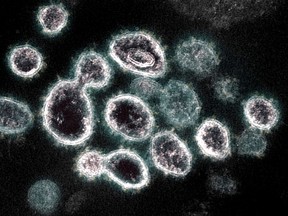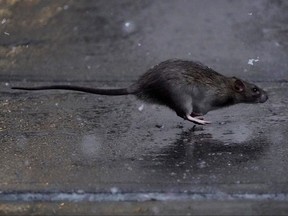The mutations have not appeared in human patients and some scientists suspect they might come from virus-infected animals

Article content
Researchers are getting some unusual results from a study of sewage waste as they attempt to decipher the origin of some COVID variants.
Advertisement
Article content
Though the mutations of note share many similarities with Omicron, they have not as yet appeared in human patients — or at least have survived undetected in sequencing. They don’t currently appear to present any extra risk to humans.
Some scientists suspect these ‘cryptic lineages’ may come from virus-infected animals, possibly the city’s enormous population of rats that skitter around the metropolis, or from cats or dogs.
Article content
In a paper published today in Nature Communications and reported in the New York Times , the scientists say these viral fragments may lead to the emergence of new variants resistant to naturally acquired or vaccine-induced immunity.
Because wastewater samples contain an amalgam of lineages — so called because they are of common descent from a known virus — the report says it is not possible to reconstruct individual genomes using standard methods. About twice a month since June 2020 they have been sequencing SARS-CoV-2 RNA isolated from the raw influent in all 14 city wastewater treatment plants. In January 2021, the Times writes, they began doing targeted sequencing of the samples, focusing on parts of the gene for the virus’s all-important spike protein.
Advertisement
Article content
Eventually, they saw that even these cryptic lineages had mutated in that time.
The researchers found that these lineages appeared repeatedly at just a handful of the 14 treatment plants, but won’t divulge their locations. Most polymorphisms remained within their own sewershed, but one location’s traces were found in a neighbouring treatment plant’s wastewater.
Article content
Four treatment plants were singled out for more detailed study. Each of the lineages found in them contained at least five polymorphisms, and one showed 16. Some contained similarities to Omicron and several showed resistance to some antibodies.
Consideration was also given to population movement in the city. The researchers were challenged by the fact that New Yorkers, and any variants they may have been carrying, generally move widely throughout the city — although numbers were far reduced from pre-lockdown periods.
Advertisement
Article content
But having been able to pin it down to a very small area of the sewershed suggests to the authors that it is not a contagious human pathogen.
John Dennehy, a virologist at Queens College in New York and an author of the paper, speculated that the sequences could be coming from people who are confined to long-term health care facilities in just a few areas of the city. But he has not been able to prove it.
Alternatively, the researchers noted, the cryptic lineages may exist in areas of the body standard swabbing tests aren’t covering. It’s possible these lineages “predominantly replicate in gut epithelial cells and are not present in the nasopharynx….”
Advertisement
Article content
Many scientists theorize that Omicron emerged from an immunocompromised patient and, indeed, people who have compromised immune systems may have more difficulty fighting off the virus, giving it more opportunities to mutate.
This is a very promiscuous virus
Virologist Marc Johnson
As the wastewater sources have been narrowed down to a certain few locations, University of Missouri virologist Marc Johnson is of the mind that the sequences are coming from animals — likely a few specific populations with territorial bounds. Supporting his theory is that in May and June of 2021, when the number of human COVID-19 cases in New York City was low, more of the odd lineages showed up in the viral RNA in wastewater, suggesting that they may have come from a non-human source.
The researchers initially considered that the source might be squirrels, skunks, dogs, cats and rats. “This is a very promiscuous virus,” Johnson told the Times. “It can infect all kinds of species.”
Advertisement
Article content

The wastewater again yielded more information, as the animals leave behind other genetic traces of themselves. Johnson created pseudoviruses with the same mutations as in the cryptic lineages. With them, he was able to infect both mouse and rat cells. While the original version of the SARS-CoV-2 virus does not appear able to infect rodents, some variants, such as Beta, can.
But, so far, there have been no signs of the virus in blood and fecal samples from local rats.
“Maybe we’re not hitting the right animals,” Dennehy said.
It has been shown that humans can pass the virus to animals, and the concern is that it may mutate there and emerge to reinfect humans.
But no evidence indicates that the virus is circulating in wild rats, and in any event it is not known how humans could have infected them.
The team is looking to other states for potential clarification on the cryptic lineages’ origins. So far, similar results have been found by scientists studying wastewater at University of California, Berkeley.
They also analyzed data “from nearly 5,000 other wastewater samples globally spanning 2020–2021, including 172 samples from New York state,” the report states. “Of all samples, only seven, all from N.Y. state sewersheds, had sequences resembling the lineages we described.”
“Nothing makes perfect sense,” Johnson said, “but we will know eventually.”
Advertisement
Unexplained 'cryptic lineages' of coronavirus found in New York City sewage. Is it the rats? - National Post
Read More








No comments:
Post a Comment